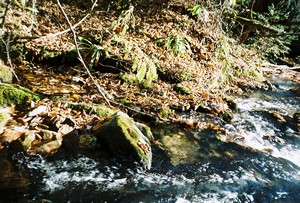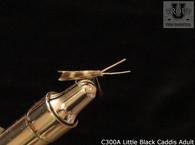Basically there are three main types of trout streams which are freestone, spring and tailwater as explained below.
Freestone
:
The freestone streams are born high in the mountains and are started by precipitation either snow melt or rain that collect into streamlets that continue to combine until they become a stream capable of supporting trout. They tend to be more acidic due their dependency on acid rain and due to the foliage surrounding them which are usually oak and hemlock trees. Since the streams usually have a hard rock base, they have little capacity to buffer the acidity of the water. To make a long story short, the higher the pH (alkalinity), the better the trout population because the aquatic insects will prosper. For a better understanding of the effect of pH please go to
427 Fly fishing Good Trout Streams vs. Poor Trout Streams.
They are characterized by having faster water with more waterfalls and more pocketwater since they are more often associated with steep changes in elevation due to their birth in the higher elevations. Also, they experience rapid changes in water level and temperatures because they are at the mercy of the rains.
Since these streams usually start high in the mountains, they often support fair populations of brook trout, and because the water does not support good aquatic life, nymphs are not the preferred choice for flies. The terrestrials like black ants will usually be far more effective as the trout will not have time to scrutinize them due to the faster flowing water.
Spring Creeks
:
Not to be confused with the season of Spring, spring creeks are the result a collection of small headwater springs or more often higher volume springs that emerge from underground caverns. They many times are flat and meander across meadows, and pastures supporting lush vegetation. They will have a more stable temperature and flow volume than does the freestone streams.
Sometimes these streams will also disappear underground as well. Often times they will come from limestone caves or formations which will account for their higher pH (alkaline) nature. Spring creeks offer a steady constant food supply for trout twelve months of the year by providing midge pupae, blue winged olives nymphs, scuds and sow bugs. In these streams nymphs and streamers are a better bet for your flies.
An excellent example of this type of stream is
Abrams Creek in the Smoky Mountains National Park. It emerges with good steady volume from an underground limestone bed and proceeds through the pastureland in
Cades Cove. It is a most rewarding stream however when fished correctly. Here, due to the quiet slow moving water, the recommendation is for a long leader with a smaller tippet to make a very delicate cast.
Tailwaters:

As a class tailwaters are the richest trout streams in the world. Dams, if they release water from the bottom of the reservoir above them, as most of the famous ones do, stabilize both flow and temperature by being miserly with spring runoff and doling it out throughout the summer. Floods are reduced, temperature extremes are moderated, and growth is easier.
Nutrients are concentrated in the impoundments behind dams. Trout also benefit in tailwaters because plankton is washed directly into the rivers and eaten by insects and crustaceans. Natural streams have little plankton because it's hard to maintain a trout population if you keep getting washed downstream, so invertebrate life in tailwaters enjoys a tremendous bonanza found in few natural environments. This explains to some extent why the Nantahala is such a favorite river.
The water temperature will remain fairly constant through the entire year often hovering in the 50 degree to 60 degree F range even in the summer. Caddis flies, midges and blue winged olives are good flies to start with using a long 8 ½ to 9 foot fly rod equipped with 3X to 5X tippet.









